Dehydrators have become increasingly popular as more and more people begin appreciating the modern ways of drying food without blowing the budget. What’s more refreshing is the fact that foods prepared with a dehydrator preserve nearly the same amount of vitamins and minerals as those found in fresh produce. Thanks to these machines, you can easily prepare your very own apple flakes or potato chips at home and add it to your favorite dish of quinoa vegan snack to create a sumptuous meal. Dried foods aren’t just limited to fruit preserves; with the help of numerous dried food recipes and cookbooks in the market, you can also dry your meat and a host of vegetables and herbs. It is important to know that well dehydrated fruits and vegetables can last many years, if sealed properly in a moisture proof bag or jar. If you are considering purchasing a food dehydrator to preserve your food, you are in the right place. As hundreds of proud owners will testify, dehydration is a simple process with many benefits. To make your life better and tastier, we’re going to tell you why you need good food dehydrators and how to go about buying one. As a bonus, we’ve also reviewed the best food dehydrator available in the market for you.
Best Food Dehydrators: Comparison Chart
| Name / Image | Price | Rating | Heater (Watts) |
|---|---|---|---|
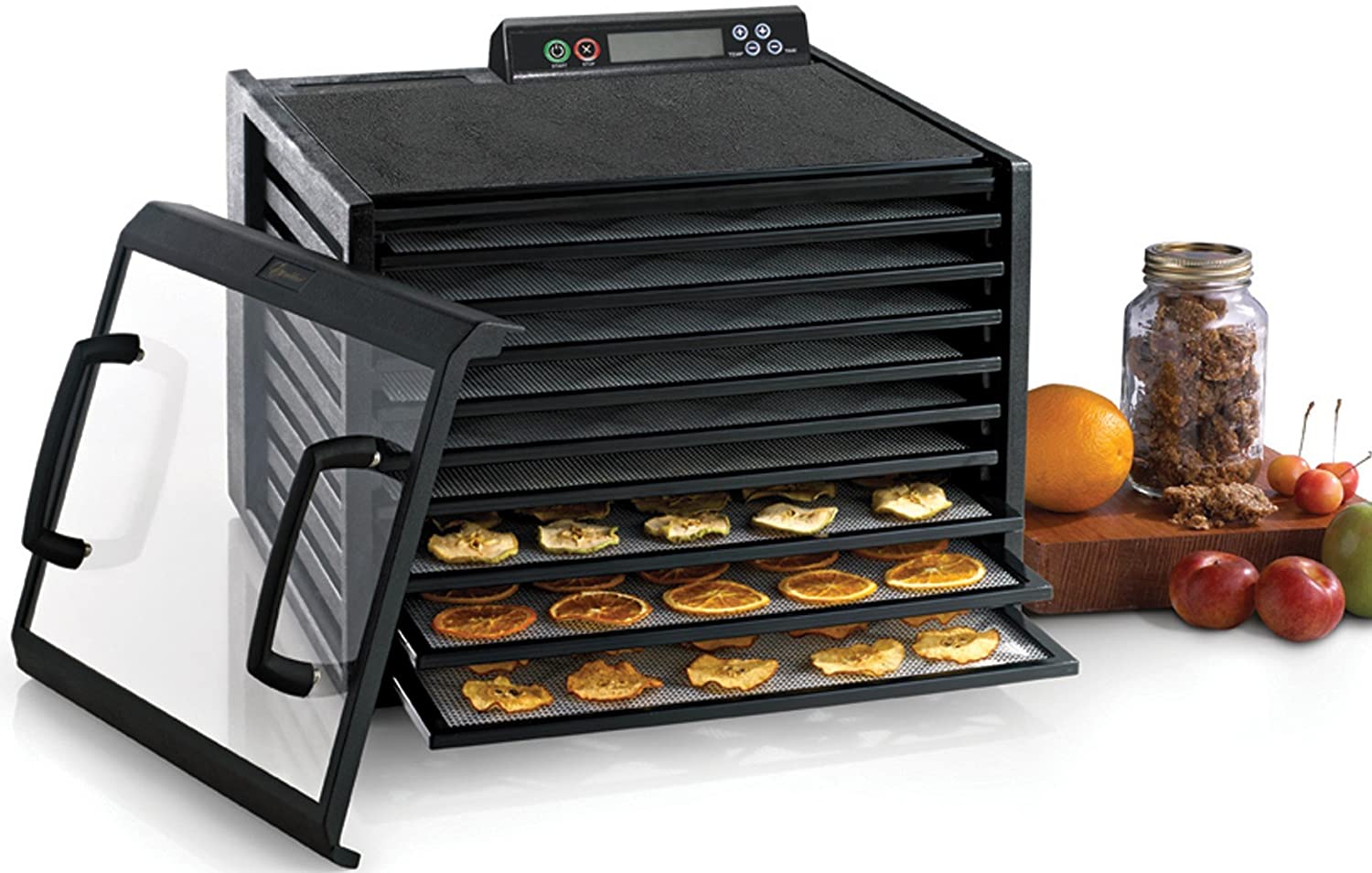 Excalibur 3948CDB | See Best Price | 600w | |
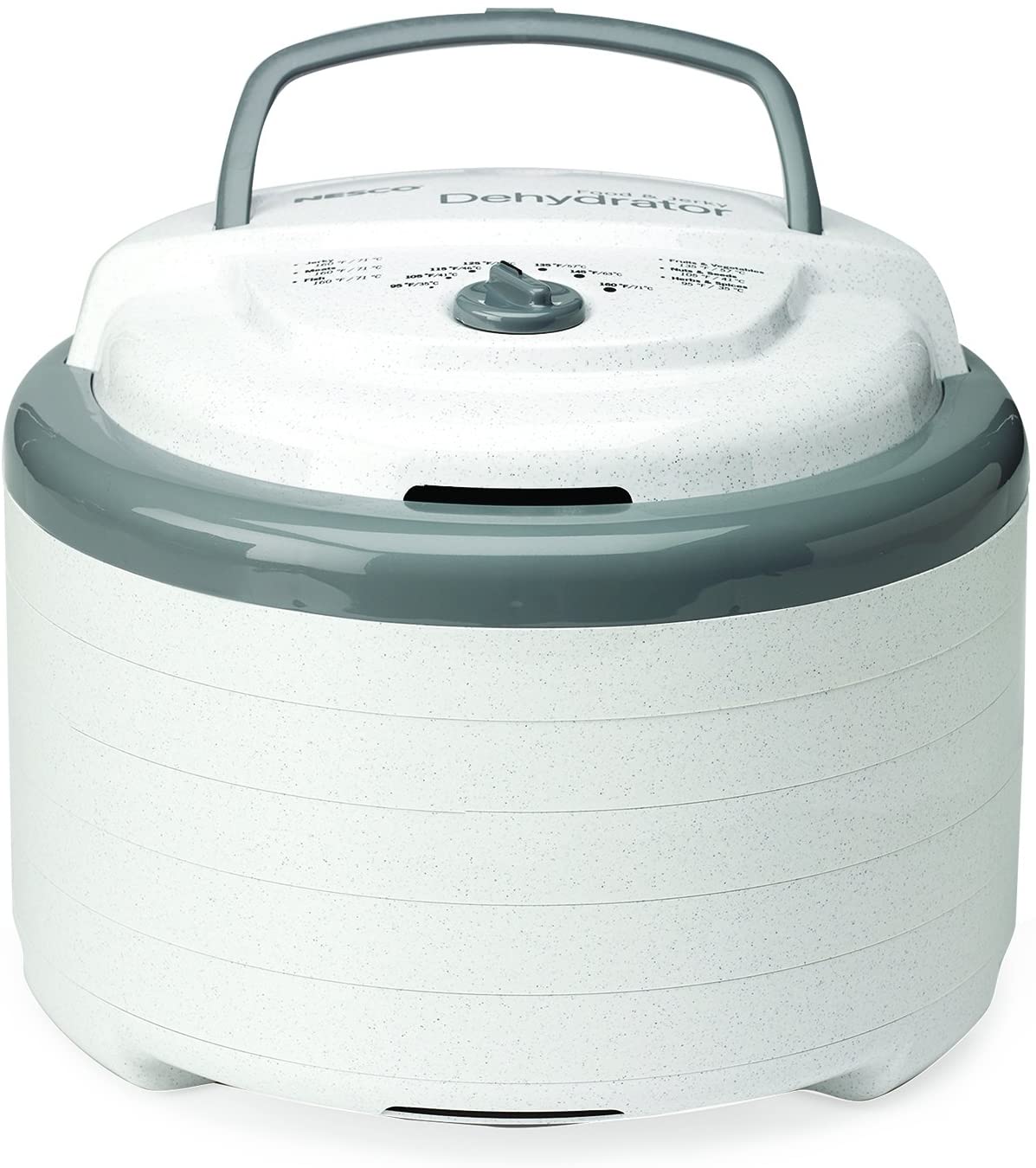 Nesco Snackmaster Pro FD-75 | See Best Price | 600w | |
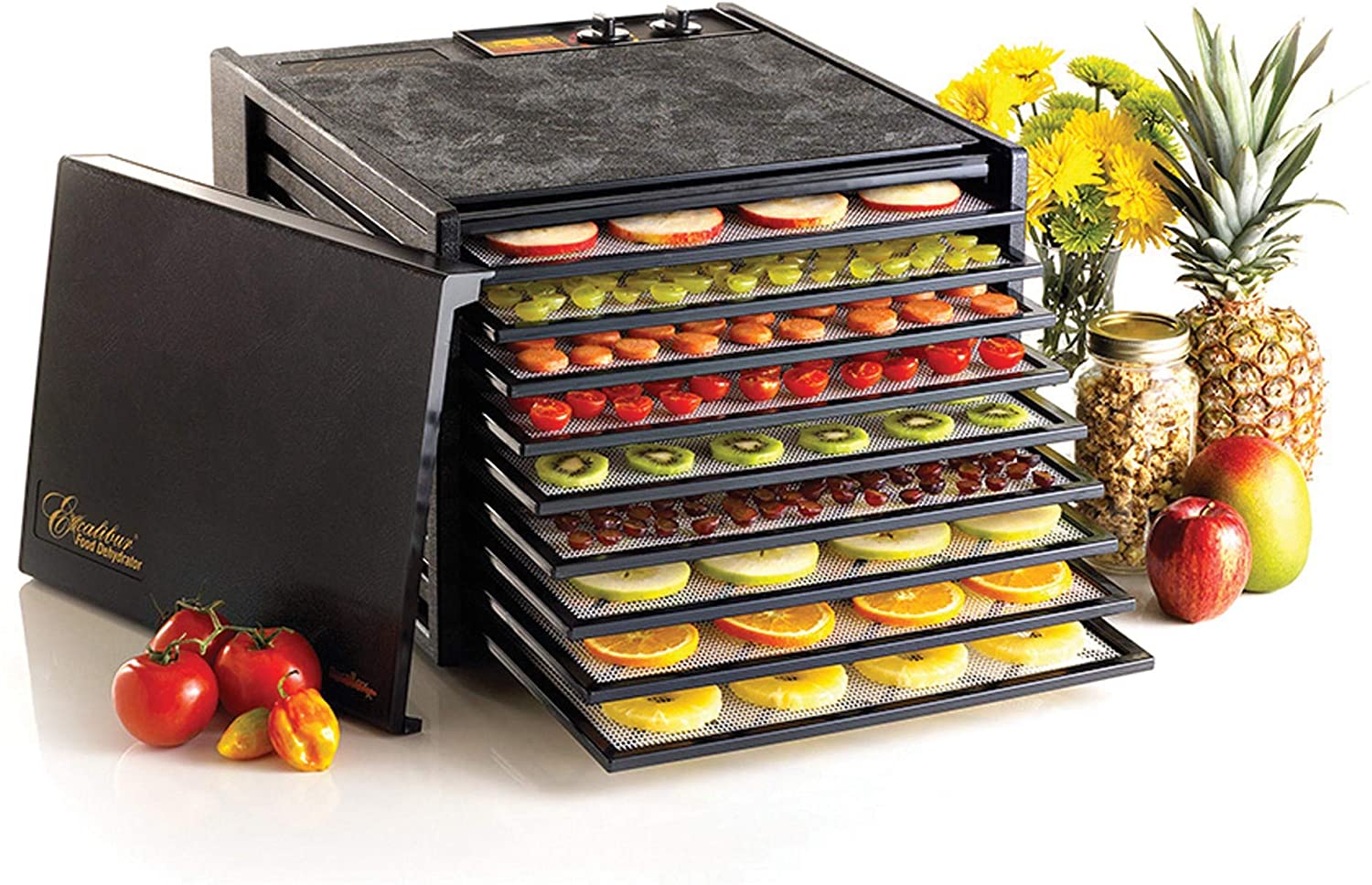 Excalibur 3926TB | See Best Price | 600w | |
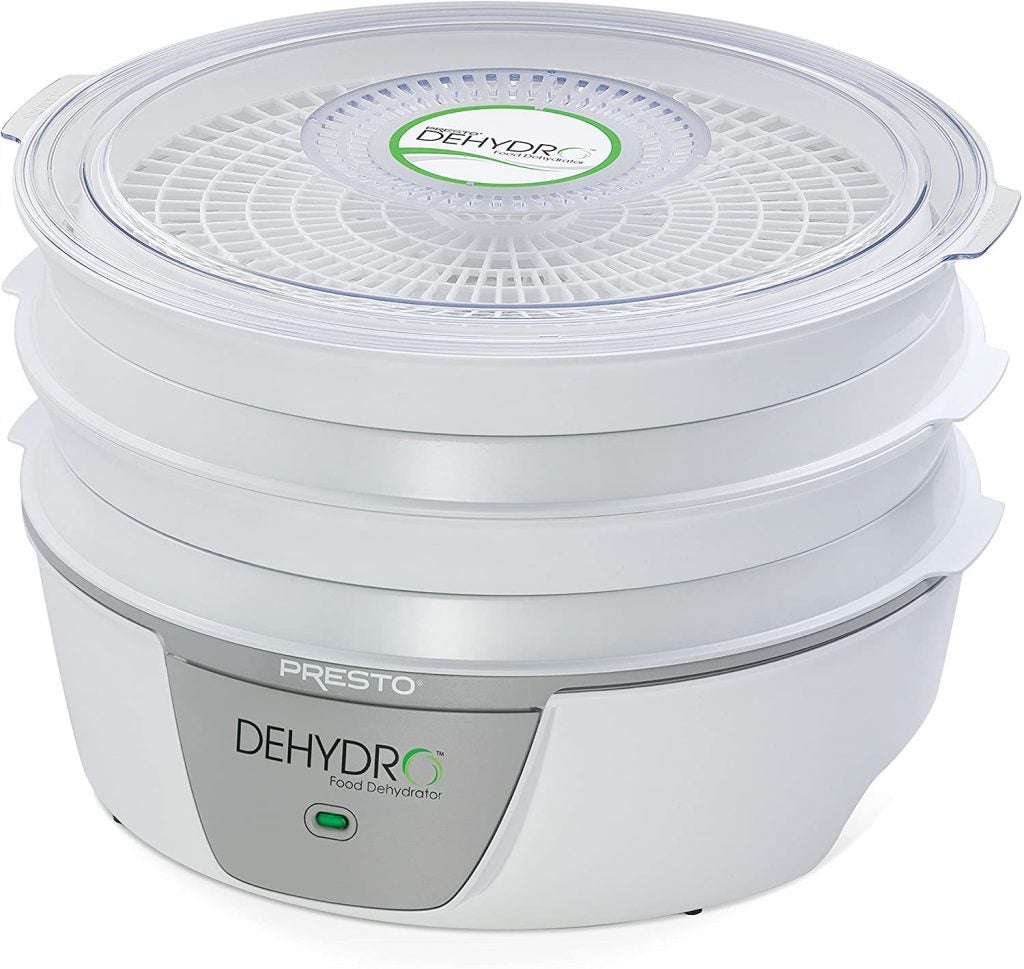 Presto 06300 Dehydro Electric | See Best Price | 600w | |
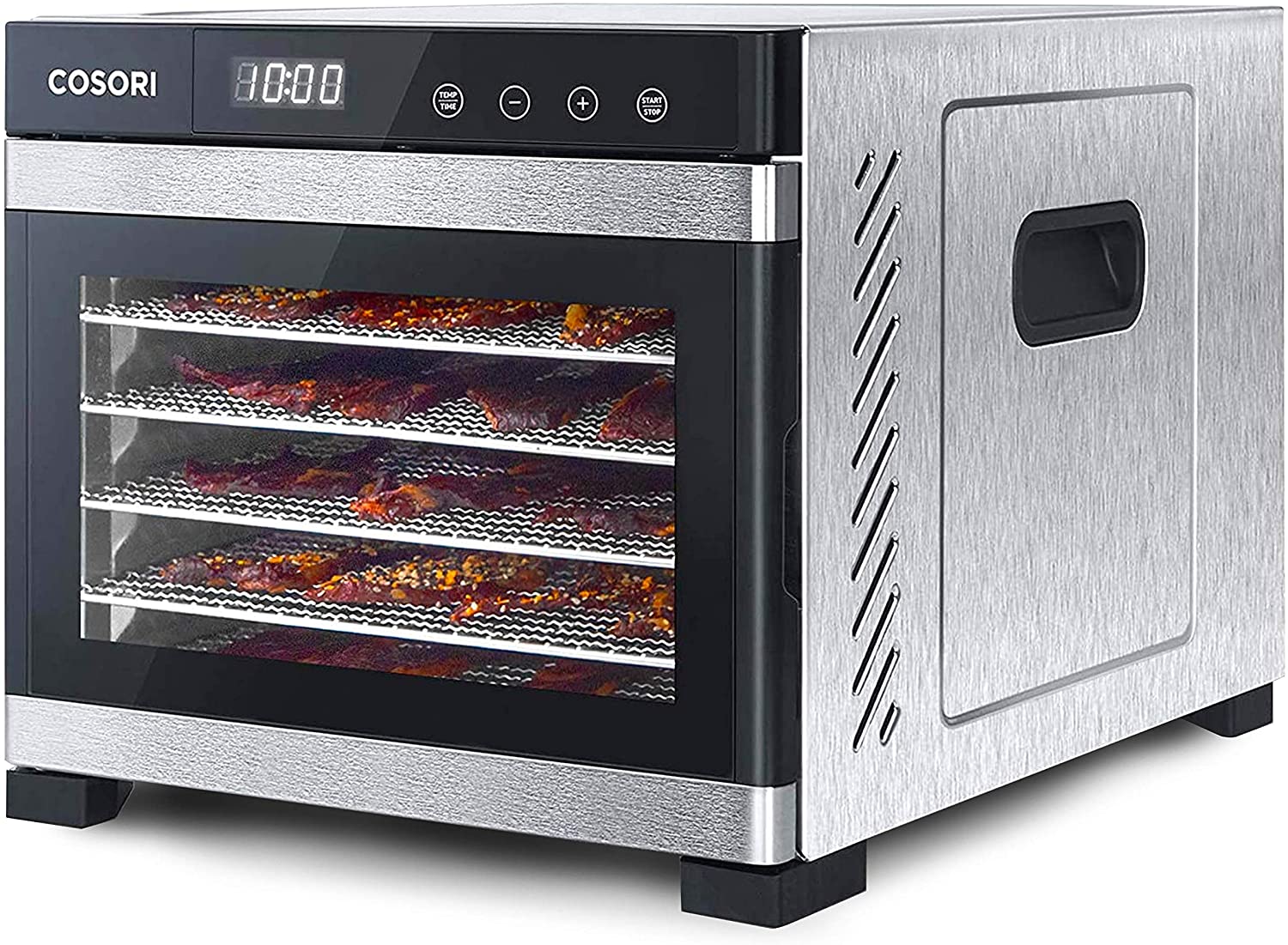 COSORI Premium Dehydrator | See Best Price | 600w |
Top 5 Food Dehydrators for 2021
1. Top Pick: Excalibur 3948CDB
Excalibur’s reputation is one of integrity, and their products are loved among those who spend quality time in the kitchen. The Excalibur 3948CDB food dehydrator is no exception, and it is considered the best dehydrator on the market. Boasting 9 trays for dehydrating, the Excalibur allows you to cook a large amount of food at one time. A two time digital controller is included, so food can be set to cook at a high temperature in the beginning of the process and then will automatically switch to a lower speed. The 48-hour timer means you don’t have to worry about your food overcooking or the dehydrator staying heated for too long. All screens are non-toxic, eliminating worries about BPA leaking into food. The doors are clear and made of polycarbonate, so monitoring food is easy. The Excalibur also gives you the ability to dehydrate a variety of foods. With a temperature range from 95°-165° F, the Excalibur is perfect for fruit that needs low temperatures to avoid enzyme degradation. However, it also works for meat that needs to cook through to make jerky, since there are high temperature settings.
2. Runner-Up: Nesco Snackmaster Pro FD-75
One of the bestselling food dehydrators of all time, Nesco Snackmaster Pro is a stacked dehydrator that boasts of a capacity of 12 racks. Even when all racks are in use, uneven heating issues are avoided courtesy of the 600-watts powerful fan and heating element that is mounted at the top of the product. This distribution of heat holds true across the extremely wide temperature range of 95°-160° F, which in turn ensures that everything from herbs and spices to beef jerky can be dehydrated with ease. To make life easier for novices, the company has also come out with a free recipe book that can teach you how to make everything from regular fish jerky to fruit rolls without having to requisition many new items. Finally, the exterior comes with Vita-Save technology that prevents the harmful external lights from penetrating into the dehydrator, and thus ensures optimal dehydration.
3. Best for Fruit: Excalibur 3926TB
A box and tray type dehydrator, the 3926TB comes with 15 square feet of drying space courtesy of the 9 trays (expandable to 15) that can be fitted into the outer shell. Excalibur understands that some foods may require longer to dry and cannot be constantly monitored, hence it has a 26 hour thermostat timer. Further, given that some foods tend to stick when kept in close proximity to other foods for long periods, the product comes with flexible poly-screen non-stick inserts that can be fitted onto the trays.
Unlike many box and shelf type dehydrators, the Excalibur 3926TB comes with a simple knob for choosing the temperature. Located at the back, it does not interfere with the handling of the product. The on and off switch, in our experience, is equally easy to operate. Both are highly responsive and do not suffer damage even when extensively used.
4. Best for Veggies: Presto 06300 Dehydro Electric
Another stacked type food dehydrator, Presto comes with a 4 tray system (expandable to 8 trays) that while being somewhat small for purposes of large scale dehydrating, is compact and weighs just 7.5 pounds. Further, there is provision for nesting of racks onto each other and storage of the power cord in the base, thus improving the portability even further—particularly great when travelling by air.
For added convenience, the top tray comes with a transparent lid that allows the person to observe the foods inside without opening the dehydrator. This allows the efficient bottom mounted fan and heating element to provide consistently hot air flow without interruption.
5. Best for Jerky: COSORI Premium Dehydrator
COSORI Premium Dehydrator created a large dehydrator that can hold its own against other brands. Priced at under $200 with 6 trays for capacity, this one is a steal. The dehydrator can be set to temperatures anywhere between 95℉-165ºF which means more precision in cooking and food that comes out just as expected. The fan in the COSORI is very quiet which is impressive considering this dehydrator has 6 trays and can evenly cook large amounts of food at one time. The clear door allows you to check the progress of the food as needed, and the sleek design will add style to any kitchen.
What is a Food Dehydrator?
Modern food dehydrators are plastic or metal boxes that can dry foods by passing hot air through them. This hot air reduces the moisture content in foods. Moisture or water content in foods is generally to the order of 50-90% of the food’s weight. As the saying goes, “water is necessary for life,” but in this case the life that flourishes because of that water in vegetables and meats consists mostly of bacteria and fungi. For now suffice it to say that such moist food, when stored away, get spoiled and pose significant health risks.
The solution is to remove water from the foods. Water cannot, and should not, be completely removed, but retained in a ratio of 0.75 to 1 to the protein content in the foods. Food dehydrators use circulating hot air to remove the excess moisture and make them storage-worthy. These foods can be consumed later, perhaps during seasons when they would normally not be available.
In our reviews, food dehydrators are sorted in two main types:
Stacked Dehydrators
Usually devoid of an outer shell, the product is made up of racks, each stack comprising of a tray for keeping foods and vents on the circumference. These stacks when placed atop each other, can be sealed such that heat does not escape the dehydrator. The fan is placed at the bottom and circulates the air in a vertical direction, thereby, they are also known as vertical flow dehydrators.
Benefits:
– Small footprint
– Size varies according to volume of foods
Disadvantages:
– Foods closer to heating element dry faster and periodic shuffling of racks is required
Box and Shelf Dehydrators
Composed of a box (also called outer shell) and shelves (also called trays), these dehydrators work like electric ovens. Trays are inserted in a predetermined fashion and a fan at the back of box blows hot air through the foods on each tray. These are also known as horizontal flow dehydrators.
Benefits:
– Better insulation
– All trays receive equal amounts of heat
Disadvantages:
– Comparatively bulky and occupy same space regardless of food volume
What to consider when buying a food dehydrator?
Though not complex machines, food dehydrators do come in a wide range of shapes and with a range of functions. But, here are the key things that you need to keep in mind when buying a food dehydrator.
- Size and Space
Do you have a small countertop with limited space, or space enough to fit an oven? If it’s the former, choose a stackable countertop model as these have minimal footprint. Instead, they have 4-30 racks that can be placed atop one another so as to scale up vertically as your dehydrating needs evolve. If you have enough space though, it is better to read through box and shelf food dehydrator reviews. Finally, whatever box and shelf model size you choose, it will be a permanent investment of kitchen space, whereas a stackable model can reduce to the size of a large lunchbox if used with only a few racks.
- Heat and Passage of Air
Stackable models have fans at the top/bottom and are notorious for uneven heating when rack levels exceed 10-12. You may find yourself rotating racks regularly to avoid over-drying of foods. If you have a lot of foods to dehydrate on a regular basis, investing in a larger box and shelf model may be more viable as these have fans at the back and dry all racks equally.
- Adaptability
If you need to dry large food pieces, you can remove the racks in a box and shelf dehydrator model and rest assured that the foods will be dried uniformly. This is not possible in stackable models as the racks fit closely onto one another. Conversely, if you expect sudden spikes in the amount of foods you expect to dry, a stackable dehydrator, with its better scalability, is ideal.
- Quality Materials
No matter what the features of the product, food dehydrators are made of either plastic or metal. If plastic, the product must have FDA certified food grade plastic that is BPA-free. It should have been tested to ensure that no plastic fumes emanate from it at high temperatures. Similarly, the metal should be part of the list of acceptable food grade materials accepted by the FDA. Regardless of the quality though, if you intend to run dehydrators for long periods at a stretch, the quality of plastic is more likely to degrade quickly compared to metal, so the latter is a good option for heavy-use.
- Portability
If you travel often by car or train, you can consider carrying your dehydrator with you. Under such circumstances, stackable dehydrators with their small size can turn out to be ideal companions. Stackable dehydrators are also light and do not cause alerts at metal detector gateways. Metal dehydrators on the other hand are bulkier, heavy, and can have rules applied against it in states which prohibit carrying of large metal objects in passenger crafts.
- Price
As the food dehydrator reviews above showed, stacked food dehydrators generally retail at prices below $75, and all-in-one stacked dehydrating solutions at prices below $100. You can however buy food dehydrators of the box and tray type only if you’re ready to shell out $200-350. Hence, if you are on a tight budget, you may want to start off with a stacked dehydrator.
How to use a food dehydrator?
- Arrange the raw material: the first step in food drying is to place or arrange the raw material on the trays. Avoid overlapping.
- Temperature setting: If you want that your food dries completely, then set the temperature to 104°F.
- Rotation of Trays: When the dehydrator starts working, check it regularly after different intervals of time and don’t forget to rotate the trays. Most fruits and vegetables take 2-19 hours for drying. To check either the food is completely dry or not, cut it into slices. When there is no moisture the food is completely dehydrated.
- Storage: When the food is dehydrated completely, cool it, and store it in an airtight container. Place the container in a dark and dry place. If you find some moisture in the leftovers, place them in the dehydrator once again for 1-2 hours.
What are the limitations?
- Home-use dehydrators are quite different from commercial-use dehydrators. So, if you want to make garlic or onion powder quickly, you can’t make it at home with a starter model.
- When drying foods like ginger or garlic, place the dehydrator in the garage, otherwise it will make the pungent smell spread throughout the house.
- Do not dry foods containing high fats, because a dehydrator can only evaporate the moisture, not fats. So the shelf life will not be stable for high fat foods.
Tips for using a food dehydrator
- A food dehydrator requires proper air circulation to work, so make sure it has proper ventilation
- Avoid overlapping of food
- Flavors might be transferred, so don’t dry the sweet and the sour together
- If the fruit or vegetable has any visible mold, don’t dry it!
- Rotate the trays to improve the drying process
Now you know how to buy the best food dehydrator
As our reviews showed, there is no clear winner. Instead, some food dehydrators can dehydrate medium amounts of food and can be ported easily, while others can handle larger amounts but are difficult to store and carry. These, along with considerations of accessibility, heating uniformity and modifiability, can decide whether a certain product is ideal for you or not. Our earlier discussion showed how a good food dehydrator can improve one’s lifestyle and finances, so deciding on the right set of requirements and using them to choose ideal food dehydrator is vital. We are sure our brief guide to buying food dehydrators will help you make these critical decisions and by doing so, improve your and your loved one’s diet for the better.
Frequently Asked Questions
How does food dehydration work?
Drying or dehydrating food involves removing the moisture content in order to prevent bacterial or mold growth. The process is performed by circulating dry heat around the food. However, the temperature of the heat is not high enough to cook the food. In this way, foods are preserved for extended periods of time without fear of spoiling.
What kinds of foods can be dehydrated?
All types of fruits, vegetables, and meats can be successfully dehydrated. Dehydrating breads creates breadcrumbs. Herbs and spices are also appropriate to undergo dehydration. You can also dry garlic or onions to make flakes or powder. Dehydration can also be used to revive soggy popcorn or potato chips. Other uses for a dehydrator include making noodles or pasta. Any food stuff which contains water can be dehydrated.
Can you dry different foods together?
In most instances, you can combine different foods in a dehydrator. It truly depends on the foods you’re combining and your dehydrator. Onions or garlic should not be dehydrated with other foods, as the contents will absorb the flavors of these items.
How long does the dehydration process take?
Dehydration commonly takes 4 to 12 hours. Resist the urge to lessen the time by increasing the dehydrator temperature. By doing this, the exterior of the foods are dried, but the interior of the foods remain moist. The exact length of time required for complete drying depends on different factors, which include:
- The amount of water content
- The amount of sugar content
- The size of each piece of food
- The amount of circulating air
- The humidity level in the chamber
- The heat temperature
- The type of dehydrator used
Not to worry though. You can find the right temperatures and time durations for all foods online, with ease that too.
How do you know when the food is completely dehydrated?
The first step in properly dehydrating food involves following the manufacturer’s instructions. Instruction manuals that accompany dehydrators typically provide guidelines for different foods. Once the process is completed, allow the food to cool. The food should feel dry to the touch and break not bend. Dehydrated food should not feel moist or sticky but leathery or hard. When in doubt, it is better to extend the dehydration process if needed.
Does dehydration affect the nutritional content of food?
The nutritional content of dehydrated foods is minimally affected. In many cases, the nutritional value is higher in food when preserved through dehydration in comparison to canning or freezing.
- Vitamin A content is not affected by dehydration. However, as the nutrient is affected by light, these foods must be stored in a dark place.
- Dehydrating vitamin C-rich foods does result in some content loss. The nutrient deteriorates when exposed to air. Since dehydrating involves circulating air, cell surfaces exposed to the heated air lose some vitamin C.
- Foods containing magnesium, potassium, sodium, or other minerals are not affected by dehydration. No minerals are lost.
- Carbohydrate and fiber content are not affected by dehydration.
- The calorie content is not changed during dehydration. Fruits may taste sweeter because the lack of moisture no longer dilutes the sugar content.
How do you store dehydrated foods?
Dehydrated foods must be kept in airtight containers or vacuum-sealed bags and labeled correctly with dates. You will want to store them in batch sizes that you can consume in one go. Why? Well, once dehydrated foods come in contact with the air, they begin absorbing moisture. The items are then likely to spoil, which defeats the dehydration process. After properly packaging dehydrated foods, store them in a cool, dark, dry place.
How long do dehydrated foods last?
After dehydrating, many foods will last up to one year if packaged properly. The storage time is extended if you place the airtight containers or vacuum-sealed bags in a refrigerator or freezer. The foods then last two to three times longer. However, in most instances, dehydrated foods are used within the first year after processing.
Do foods require any treatment before dehydration?
Pre-treating certain foods may improve the color and flavor. For example, apples and pears tend to oxidize and turn brown if not treated with lemon juice.
What’s the difference between dehydrated and dried foods?
Properly dehydrated foods have more moisture removed. Dried foods are commonly soft, sticky, or flexible. Dehydrated foods are crisp, leathery, or hard. Dehydrated foods also last longer in storage compared to dried foods.
What are the benefits of dehydrating foods?
- Processing foods is an ideal way to control the quality of the foods eaten and served
- Dehydrating saves money by preserving garden harvests for year-round use
- Foods are often less expensive when bought in bulk. By dehydrating the foods, you need not worry about spoilage
- They are a great way to eat healthy, whether talking about snacks like fruit leathers and meat jerky or dehydrated meals
- As dehydrated foods are lightweight and require less space, they are great for taking on hikes, road trips, or camping trips
Additional resources
- https://sousvideguy.com/dehydrate-food-beginners-guide/
- https://sousvideguy.com/dry-fruits-vegetables-using-food-dehydrator/
- https://sousvideguy.com/recipe/recipe-for-dehydrated-whole-grain-crackers/
- https://sousvideguy.com/recipe/dehydrated-crunchy-buckwheat-granola-recipe/
- https://sousvideguy.com/dehydrate-food-top-5-reasons-preserving-food-dehydrator/
- https://sousvideguy.com/why-and-how-to-dehydrate-food/

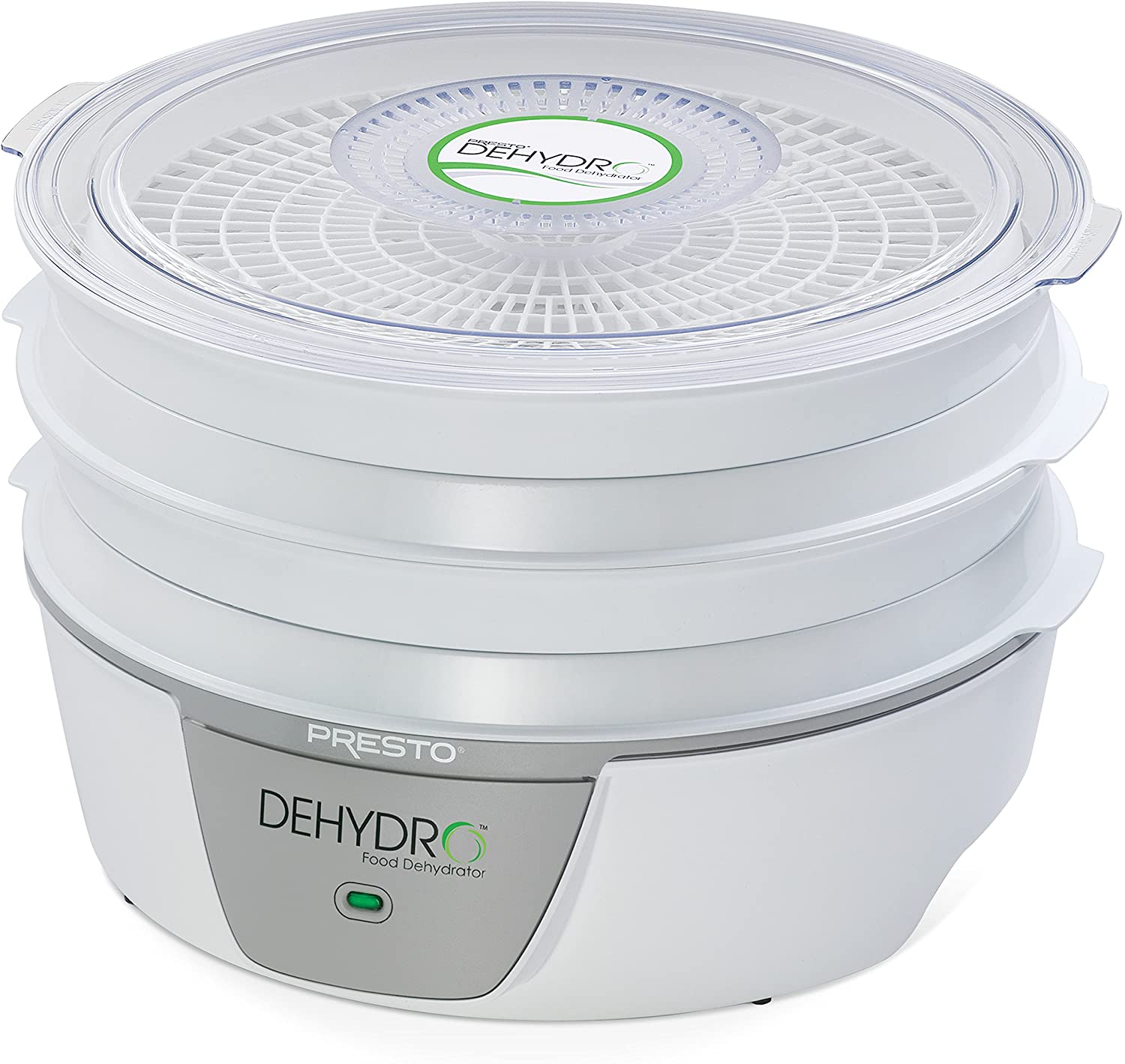
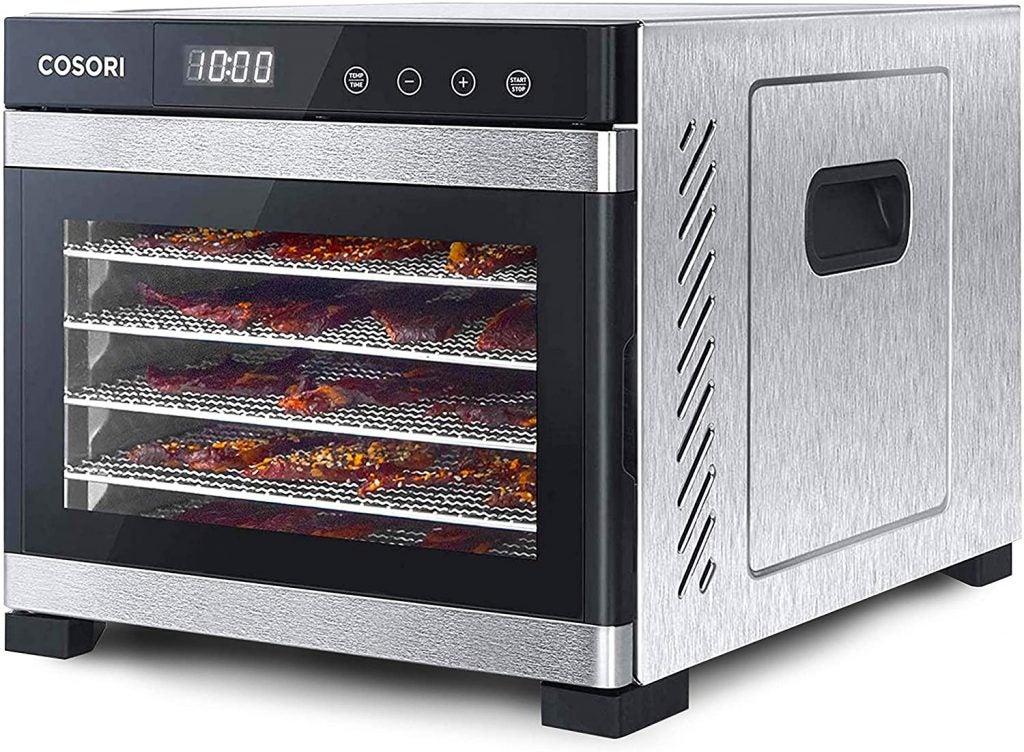
What about cleaning trays? Are any of them dishwasher safe?
To safe, you should clean it by hand
What about Himmel, the Korean brand dehydrator?
Most dehydrator trays are hand wash, but the product should say whether it’s a necessity when you buy it.
Hi Elle!
We will add this information to review. Thank you.
Have you done any testing as to noise ?
We have the Nesco FD-37A and it’s a noisy beast, though it dries quite well.
We usually take it upstairs because of the noise.
Regards,
Dear George!
The noise emitted from the fan. You can leave a reasonable weight on the top of product, will reduce the noise.
However we do not recommend this solution. To resolve completely, refer to Pro NESCO FD-75A.
Regards,
Hello,
I would like to have one, but all the dehydrators are 110 V power, and where I live is 220 V?
Can you please suggest which type of power inverter is suitable for them?
Regards
I am little concern of plastic made trays. Are they safe to eat after the fruits high temp on the plastic mesh.
I like to see the tray made of metal not plastic!!
The up to 10 try units are fine for in home use. Both the plastic and metal models work well. I have found the need to rotate both 5 and 10 tray units for even drying. How about something bigger that can dry evenly and more volume?? Looking to make large quantities in a hurry. Can you recommend any dependable commercial grade units.
For commercial use, I would suggest this dehydrator:
DELLA 1200W 10-Tray Food Dehydrator
I saw a comment somewhere that said you can dehydrate by halogen. Wondering if this means an ordinary halogen oven or are there specific halogen dehydrators?